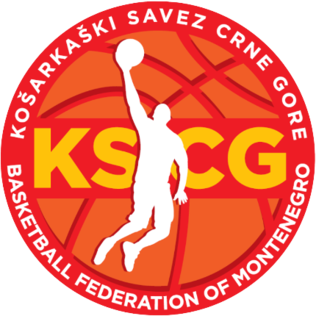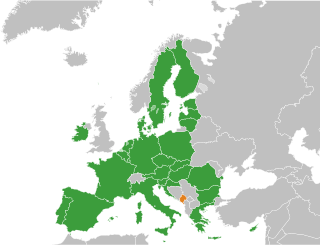
Montenegro is a country in southeast Europe on the Adriatic coast of the Balkans. It borders Bosnia and Herzegovina to the north, Serbia to the northeast, Kosovo to the east, Albania to the southeast, the Adriatic Sea and Croatia to the west. The largest and capital city Podgorica covers 10.4% of Montenegro's territory and is home to 29.9% of the country's population, while Cetinje has the status of old royal capital. Major group in the country are Montenegrins. Serbs form a significant minority at 28.7%, followed by Bosniaks, Albanians and Croats.

The Federal Republic of Yugoslavia, commonly referred to as FR Yugoslavia or simply Yugoslavia, was a country in the Balkans, which came into existence in 1992, following the breakup of the SFR Yugoslavia. It comprised the Republic of Serbia and the Republic of Montenegro, the two remaining republics of Yugoslavia. In February 2003, FR Yugoslavia was transformed from a federal republic to a political union, and became officially known as the State Union of Serbia and Montenegro. In 2006, Montenegro seceded from the union, following independence referendum which narrowly passed, leading to the full independence of Serbia and Montenegro.
Montenegrins are a South Slavic ethnic group native to Montenegro.
Montenegrin is a normative variety of the Serbo-Croatian language mainly used by Montenegrins and is the official language of Montenegro. Montenegrin is based on the most widespread dialect of Serbo-Croatian, Shtokavian, more specifically on Eastern Herzegovinian, which is also the basis of Standard Croatian, Serbian, and Bosnian.

Bijelo Polje is a town in northeastern Montenegro on the Lim River. It has an urban population of 15,400. It is the administrative, economic, cultural and educational centre of northern Montenegro.

The economy of Montenegro is currently in a process of transition, as it navigates the impacts of the Yugoslav Wars, the decline of industry following the dissolution of the Socialist Federal Republic of Yugoslavia, and economic sanctions imposed by the United Nations.

The municipalities are the first level administrative subdivisions of Montenegro. The country is divided into 24 municipalities including the Old Royal Capital Cetinje and the Podgorica Capital City. Podgorica is divided into one subdivisions called city municipality, forming the basic level of local government.

Montenegro has participated in the Eurovision Song Contest 11 times. The country debuted in 2007. Previously it had participated as part of Yugoslavia and as part of Serbia and Montenegro.

Islam in Montenegro refers to adherents, communities and religious institutions of Islam in Montenegro. It is the second largest religion in the country, after Christianity. According to the 2011 census, Montenegro's 118,477 Muslims make up 20% of the total population. Montenegro's Muslims belong mostly to the Sunni branch. According to the estimate by the Pew Research Center, Muslims have a population of 130,000 (20.3%) as of 2020.

The Montenegro national football team has represented Montenegro in international football since 2007. It is controlled by the Football Association of Montenegro, the governing body for football in Montenegro. Montenegro's home ground is Podgorica City Stadium in Podgorica.

In a referendum on 21 May 2006, the people of Montenegro opted to leave the State Union of Serbia and Montenegro. This result was confirmed with a declaration of independence by the Montenegrin parliament on 3 June 2006. It simultaneously requested international recognition and outlined foreign policy goals.

The Football Association of Serbia and Montenegro was the governing body of football in Serbia and Montenegro, based in Belgrade. It organized the football league, the national team, the cup tournament as well as the Second Leagues of both republics.
Religion in Montenegro refers to adherents, communities, institutions and organizations of various religions in Montenegro. While Eastern Orthodox Christianity is the dominant religious denomination in Montenegro, there are also sizable numbers of adherents of both Catholic Christianity and Islam. The dominant Church is the Serbian Orthodox Church although traces of a forming Montenegrin Orthodox Church are present. According to the 2020 estimate by the Pew Research Center, 76.6% of the population is Christian, 20.3% are Muslims, and 3.1% are unaffiliated.

The Montenegro men's national basketball team represents Montenegro in international basketball tournaments. The supervising body is the Basketball Federation of Montenegro.

Accession of Montenegro to the European Union (EU) is on the current agenda for future enlargement of the EU.
Miss Montenegro is a national Beauty pageant in Montenegro.

Turks in Montenegro, also known as Turkish Montenegrins and Montenegrin Turks, are ethnic Turks who form an ethnic minority in Montenegro.

Denmark – Montenegro relations refers to the current and historical relations between Denmark and Montenegro. Denmark is represented in Montenegro through its embassy in Belgrade, Serbia, and have an honorary consulate in Podgorica. Montenegro is represented in Denmark through its embassy in Belgrade, Serbia. Denmark recognized Montenegro on 15 June 2006 and diplomatic relations were established same day. Denmark assists Montenegro under the Neighborhood Programme. The assistance focuses on agricultural production. Both countries have signed an agreement about protection of investments.
The Montenegro women's national basketball team represents Montenegro in international women's basketball tournaments. The supervising body is the Basketball Federation of Montenegro.
The Montenegrin women's national team entered international competition in 2008, playing their first official match on 27 August, against Republic of Ireland in Bijelo Polje (68–56).
The Montenegrin women's team participated at the EuroBasket Women four times – 2011, 2013, 2015, and 2017 reaching the quarterfinals twice.

Serbs of Montenegro or Montenegrin Serbs, compose the second largest ethnic group in Montenegro, after the Montenegrins. Additional 0.64% of the population is made up of Serbs-Montenegrins and Montenegrins-Serbs. Serbs are a native population of Old Montenegro, Old Herzegovina, Brda, Raška, Bay of Kotor and Zeta.














